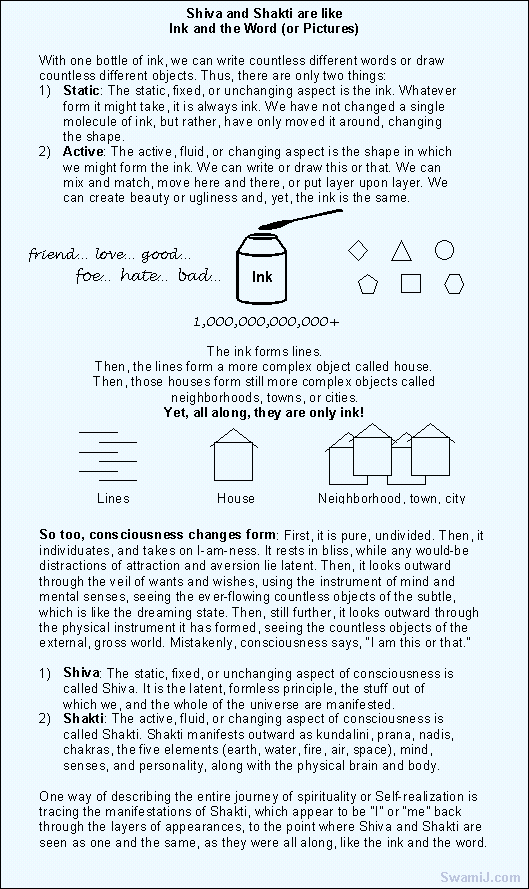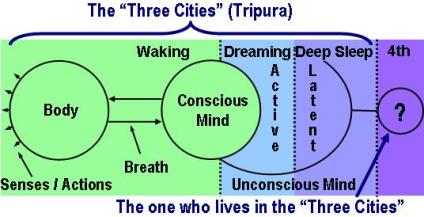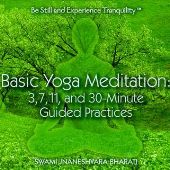|
Home CDs Schools Tantra Shakti Yoga/Vedanta/Tantra Yoga Sutras |
|||||||||||||||||||||||||||||||||||||||||||||||||||||||||||
|
|
See also: Meditation home page CDs
Kundalini is innate for all people: At the base of the spine, subtler than the physical body, lies the Kundalini energy, or spiritual energy, in a latent form. Regardless of what religious, spiritual, or meditation tradition one follows, the awakening of this energy, by whatever name you call it, is a most innate and essential part of spiritual advancement, unfoldment, or realization. All Yoga is Kundalini Yoga: While some people use a specific terminology "Kundalini Yoga" for certain practices, all of Yoga actually leads to the activation of Kundalini. Thus, in a sense, all of Yoga is Kundalini Yoga, regardless of whether you use that specific name. Awakening kundalini and leading it to union with the Absolute is the goal of the Himalayan sages and the path of Yoga, Vedanta, and Tantra.
Stages in Kundalini Awakening: The graphics above display the seven major chakras (section #5), the left and right energies of Ida and Pingala (section #1), and the Sushumna nadi, the central channel that courses through the chakras (Sushumna is sometimes called "silver cord"). The six graphics visually represent the process of Kundalini Awakening. Clicking on each of the six graphics will move you through explanations of the stages. Also, there is an index for the contents of these pages. The six stages are:
Number of stages in Kundalini Awakening: There is nothing especially significant about describing this Kundalini Awakening in six stages (the six graphics), as opposed to some other number; it is simply a convenient way to explain the process. The simplest way of describing the entire process is in three stages:
One energy with many names and forms: There is one energy (Shakti) that keeps taking on new shapes and forms. Each time the energy takes on a new form, we give it a new name. See the article Kundalini, Shakti, and a River for an explanation of these names and forms. Shiva and Shakti: Tantra considers the universe to be a manifestation of pure consciousness. Through this process of manifesting, consciousness divides itself into two parts, which, though seeming to be separate, cannot exist without one another.
The Secret of Shiva and Shakti: Science and physics: Modern science also considers these two forms of energy, though viewing them in different ways. Science includes, for example, potential energy and kinetic energy (the energy of motion), recognizing that they are both manifestations of the same underlying energy. Tantra describes the unification of all as the pouring out of the energy of consciousness through the manifestation of the static (Shiva) through a veiling and projecting process (Shakti), creating the levels of the universe. At the physical level, modern physics also seeks to find a unifying source, and is in the process of explaining this unification through quark and string theories. Like ink and the word: Shiva and Shakti are inseparable and coexist, like ink and the written word, which, though one and the same, are different. With one pen of ink, many different words or images can be manifested, although there remains only one container (pen) of ink. It is that creative process of manifestation that makes the ink appear to have different forms and meaning from one word to the next. When you write different words, or draw both a circle and a square, you have not created a single ink molecule, but have only rearranged the existing molecules, creating the appearance of different words or forms. It remains exactly what it was in the first place, which is ink. This is not negative or merely intellectually reductionistic, but is a most awesome, beautiful process. Similarly, the unmanifest Shiva can manifest into countless forms through the creative appearance of Shakti. Simple metaphors such as ink and written word can be extremely useful to contemplate on, so as to understand the principle of the one appearing to be two, and how these two dance together to form the elegant complexity of manifest reality. Experiencing their union: The journey of Tantra and Kundalini Yoga leads to Kundalini Awakening and to the realization of the Absolute, where these two apparently different aspects of manifestation are experienced in their original union. Yoga means union, or joining, and this union of the static and the dynamic is the meaning of Yoga (see also Yoga Sutras, particularly sutras 1.1-1.4, which define Yoga). Through the process of going ever deeper or higher in practices relating to your own constitution, one repeatedly comes to see the way in which seemingly different realities and self-identities are only apparent, and that manifestation is the mere play of the creative aspect of Shakti with the static aspect of Shiva. Concepts of Shiva and Shakti: As with many principles of reality, some religious people and traditions conceptualize Shiva and Shakti as anthropomorphic deities, while others view the two as principles and processes of the universe. In either case, the journey of Kundalini Awakening is an inner experience, going from gross to subtle, to subtler, and subtle most, to one's own center of consciousness, by whatever name you choose to call that. In this article, Shiva and Shakti are seen to be the two principles and processes of static and dynamic, as noted several paragraphs above.
Meaning of kunda and kundala: Kunda means bowl, or cave, and refers to the bowl of fire of consciousness resting in the first chakra at the base of the spine. Lini refers to that which resides in that bowl. Kundala means coiled, as the Shakti forms in a coil there. Meaning of shak: The word shak is the root word of Shakti, and means to be able, or to have power. Hence, Kundalini Shakti is the power of consciousness that is coiled in a latent form, in the base of the spine. External and internal practice: For those who are lesser prepared, the path of external practices (bahiyayag) is preferred, which may include external forms of rituals or symbolic gestures. For those who are prepared, the path of internal practices (antaryag) is available, which involves making the mind one-pointed and doing introspection. Kaula, mishra, and samaya tantra: The three schools of tantra are kaula, mishra, and samaya. The kaula school starts with the lower chakras, and involves external practices. The mishra school also works with external practices, and emphasizes the central chakras. The samaya school is the highest, emphasizing the upper chakras. It involves no external practices, focusing only on the inner (antaryag) practices. (The Tantra practice of Yoga Nidra is extremely effective in opening, balancing and purifying the chakras. See also the page describing the Yoga Nidra CD.) Regulating the primitive inclinations: Before treading the later stages of Kundalini Awakening, it is very important to manage the basic urges. Otherwise, the surge of energy may not be handled very well. This means regulating the four primitive fountains of food, sleep, sex, and self-preservation. Spontaneous Kundalini Awakening: The approach of these writings is to describe the systematic process of intentional Kundalini Awakening. However, it may also come spontaneously to people who have done no intentional practices. One may argue that spontaneous awakening may be coming as a result of previous practices that are not remembered, but in either case the perception of the individual may be that nothing was done to bring forward the experience. Integrating the effects: Regardless of whether Kundalini Awakening comes spontaneously or through practices, there may be some amount of time and effort needed to integrate the effects of such experiences into the body and personality. It is a time when stabilizing actions are important, including daily exercise, high quality food, regular sleep patterns, and healthy relationships with other people. During this time is very useful to be around someone who has knowledge of this process, and has experienced it personally. Preparation is most important: Preparation is much more important than the practices of Kundalini Awakening themselves. If one skips the basics and the preparation of body, breath, and mind, then the surge of energy can be more disruptive than beneficial. In the Himalayan tradition Yoga, Vedanta, and Tantra go together, with a solid foundation being built first. The practices of Yoga Nidra and bhuta shuddhi (chakra meditation) can be quite useful.
-------
|
|
|||||||||||||||||||||||||||||||||||||||||||||||||||||||||














